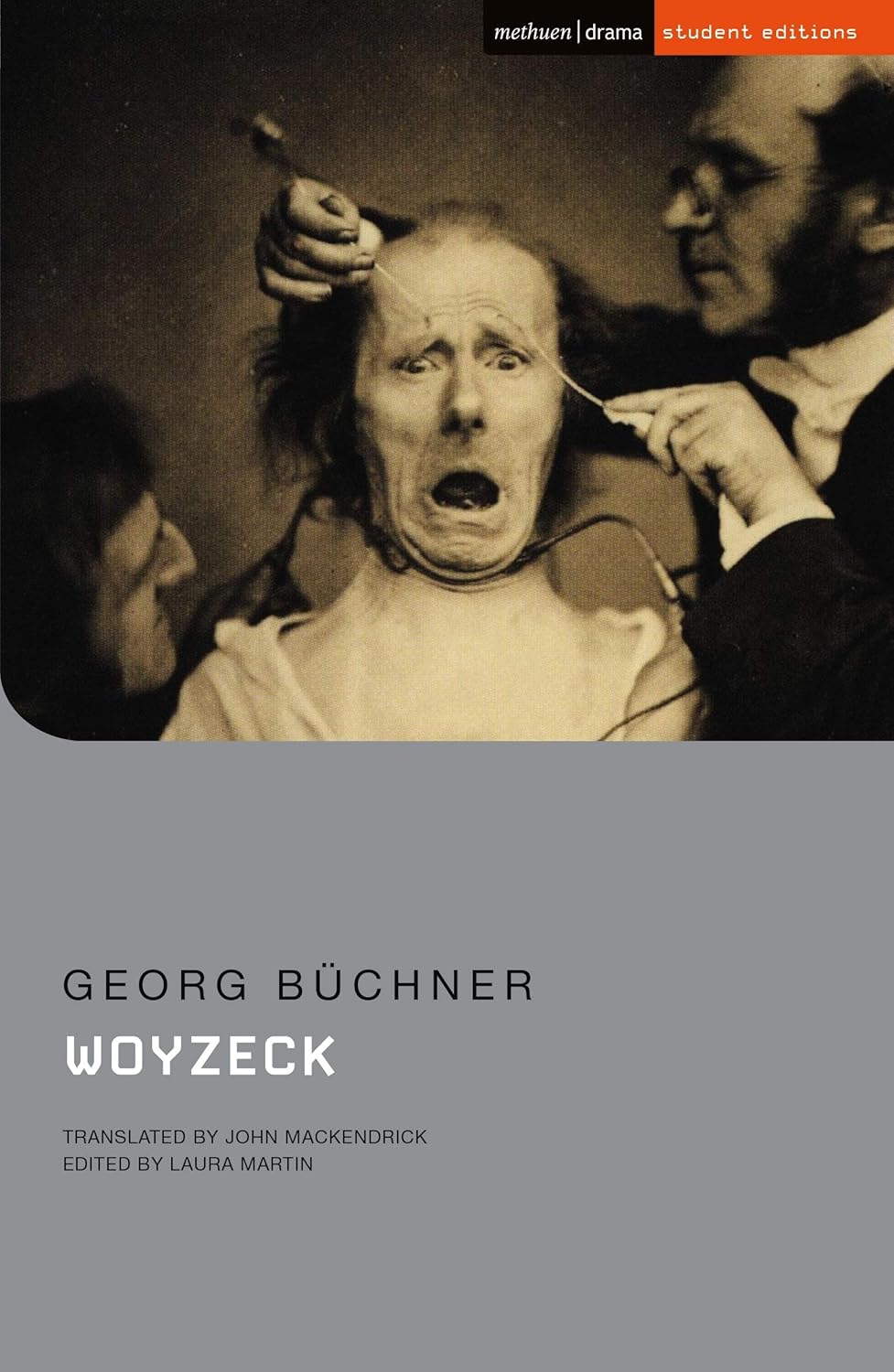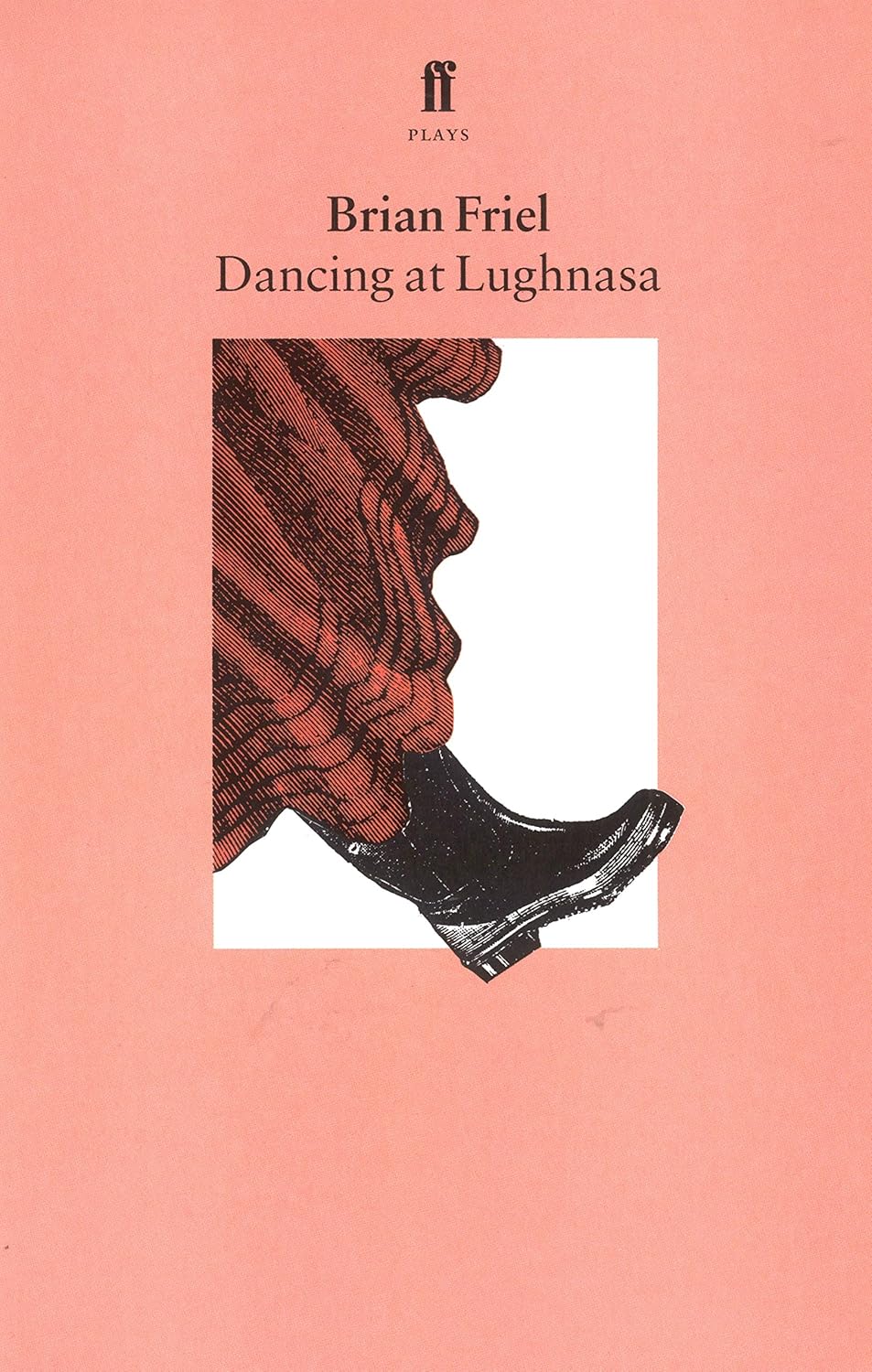The Birth of Modern Drama
Picture a soldier, so poor he must submit himself to medical experiments to support his child, slowly descending into madness while military drums beat in the distance. This is Franz Woyzeck, the protagonist of Georg Büchner’s groundbreaking play, left unfinished at his death in 1837. Through this simple soldier’s tragedy, Büchner revolutionized theater, creating what many consider the first truly modern drama.
Quick Facts
- Written: 1836-1837
- First performed: 1913 in Munich (76 years after Büchner’s death)
- Original language: German
- Based on: The real-life case of Johann Christian Woyzeck, executed in 1824
- Runtime: Typically 90-120 minutes
- Notable adaptations: Alban Berg’s opera “Wozzeck” (1925), Werner Herzog’s film (1979)
- Structure: Fragmentary scenes, order often determined by directors
Just want to read the play?

Victor Price translation
A very accessible translation. Also Includes Danton’s Death, Leonce and Lena.

John Mackendrick translation (student edition)
Contains extra contextual materials such as annotations, the play’s social and political context, and its performance history.

Gregory Motton translation
Pocket size NHB edition, with student notes. Fast-paced modern translation. Great for performance.

Werner Herzog’s film adaptation
Starring Klaus Kinsky as Woyzeck and Eva Mattes as Marie. Not to be missed.
Free version? Try the version on Project Gutenberg: https://www.gutenberg.org/ebooks/5322
Historical Context
When Georg Büchner began writing Woyzeck in 1836, Europe was in the midst of massive social upheaval. The Industrial Revolution had created new forms of poverty and exploitation, while revolutionary movements simmered beneath the surface of society. Büchner, a young revolutionary and scientist, drew inspiration from a notorious murder case: in 1821, Johann Christian Woyzeck, a Leipzig wigmaker and soldier, stabbed his lover to death in a fit of jealousy. He was publicly executed in 1824 after a controversial trial that centered on questions of sanity and free will.
The real Woyzeck’s case sparked debate about mental illness, criminal responsibility, and social justice—themes that Büchner would transform into a searing indictment of class exploitation and military authoritarianism.
Plot Overview
Franz Woyzeck, a low-ranking soldier, lives with Marie, the mother of his illegitimate child. To earn extra money, he serves as a servant to the Captain and subjects himself to dehumanizing medical experiments by the Doctor, who feeds him nothing but peas. As Woyzeck’s mental state deteriorates, Marie begins an affair with the Drum Major, a pompous military figure. Plagued by apocalyptic visions and haunted by voices, Woyzeck eventually murders Marie by a pond and walks into the water himself.
What makes this simple plot revolutionary is Büchner’s presentation: through a series of short, fragmented scenes, we experience Woyzeck’s world as he does—disconnected, overwhelming, and increasingly nightmarish.
Themes & Analysis
The Dehumanization of the Poor
At its heart, Woyzeck is about human dignity under assault. The Captain lectures Woyzeck about morality while ignoring his economic reality. The Doctor treats him as a laboratory animal, proudly announcing to his medical students how Woyzeck, like a cat, has been trained to urinate on command. These supposedly civilized members of society see Woyzeck not as a human being, but as a thing to be used.
Madness and Rationality
Is Woyzeck truly mad, or is his “madness” a rational response to an insane world? Büchner’s genius lies in making both interpretations possible. The voices Woyzeck hears might be symptoms of mental illness—or they might be his consciousness processing the real horrors of his existence. The play’s fragmentary structure mirrors this ambiguity, leaving us uncertain whether we’re seeing reality break down or reality finally revealed.
Nature and Science
The Doctor’s “scientific” experiments represent the Enlightenment’s dark side—reason twisted into instrument of torture. Meanwhile, nature appears to Woyzeck as both threatening and prophetic. The recurring motif of water, culminating in the murder by the pond, suggests both cleansing and drowning, both escape and destruction.
Revolutionary Elements
Woyzeck broke almost every theatrical convention of its time:
- It made a lower-class soldier its tragic protagonist
- It used fragmentary, non-linear scenes
- It mixed comedy and tragedy
- It employed naturalistic dialogue
- It introduced social criticism into tragedy
- It questioned free will and moral responsibility
These innovations influenced virtually every major theatrical movement that followed, from Naturalism to Expressionism to Epic Theater.
Cultural Impact
While Woyzeck wasn’t performed until 1913, its influence has been enormous:
- Alban Berg’s opera “Wozzeck” (1925) revolutionized 20th-century music
- Bertolt Brecht cited it as a major influence on his Epic Theater
- Werner Herzog’s 1979 film adaptation starring Klaus Kinski became a classic
- Tom Waits created a dark musical version in 2000
- The play continues to influence discussions about mental health and criminal responsibility
Staging & Performance
Woyzeck presents unique challenges and opportunities for theater makers:
- The fragmentary nature allows directors to order scenes differently
- The balance between naturalism and expressionism must be carefully managed
- The portrayal of Woyzeck’s mental state requires sophisticated performance techniques
- The play’s social criticism must speak to contemporary audiences
Reading Guide
Best Translations
- Michael Hofmann (most poetic)
- Gregory Motton (most performable)
- Victor Price (most accessible)
Reading Tips
- Pay attention to recurring motifs: water, blood, nature
- Notice how the language changes between social classes
- Track the progression of Woyzeck’s mental state
- Consider how each scene could be ordered differently
Contemporary Relevance
Woyzeck’s themes resonate powerfully today:
- Economic exploitation and inequality
- Military trauma and PTSD
- Medical ethics and human experimentation
- Mental health and social responsibility
- Class divisions and moral judgment
Fun Facts & Trivia
- Büchner died of typhus at 23, leaving the play unfinished
- Different versions of the play exist due to multiple drafts
- The real Woyzeck was executed by sword rather than guillotine due to his social status
- Büchner based some of the Doctor’s dialogue on his own medical lectures
Why This Play Endures
Woyzeck endures because it speaks to fundamental human experiences: poverty, love, jealousy, exploitation, and the search for dignity in an indifferent world. Its innovative structure and unflinching social criticism made it the first truly modern play, while its psychological complexity and poetic power make it eternally contemporary.
Additional Resources
- Georg Büchner: Revolution and Romance by Michael Patterson
- Büchner: Complete Plays (Methuen Drama)
- The Making of Modern Drama by Richard Gilman
- Various recorded productions available through Digital Theatre Plus
Whether you’re a theater professional, a literature student, or simply someone who cares about human dignity and artistic innovation, Woyzeck demands and rewards your attention. In its broken fragments, we see our own world more clearly—and perhaps glimpse ways to make it better.
Remember: while the play ends in tragedy, Büchner’s message isn’t one of despair but of protest. By showing us Woyzeck’s humanity, he demands we recognize our own in others, especially those society would rather ignore.




Leave a Reply